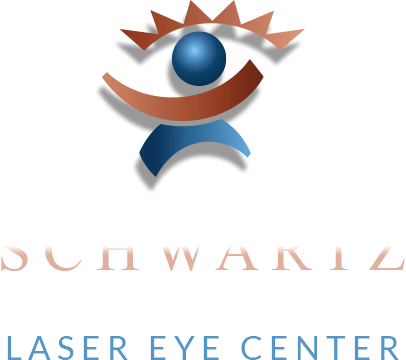 An intraocular lens implant, or IOL, replaces the eye’s cloudy lens during cataract surgery. Everyone has unique vision requirements and goals, which is why Dr. Jay Schwartz and our team at Schwartz Laser Eye Center offer several types of IOLs to suit a variety of needs. One option is Bausch + Lomb’s Crystalens AO accommodating lens, which treats not only cataracts but also presbyopia (the age-related loss of near and intermediate vision). Crystalens is able to improve near vision without compromising intermediate or distance vision. More than twice the number of patients with Crystalens reported seeing clearly at all distances, compared to patients with standard IOLs.
An intraocular lens implant, or IOL, replaces the eye’s cloudy lens during cataract surgery. Everyone has unique vision requirements and goals, which is why Dr. Jay Schwartz and our team at Schwartz Laser Eye Center offer several types of IOLs to suit a variety of needs. One option is Bausch + Lomb’s Crystalens AO accommodating lens, which treats not only cataracts but also presbyopia (the age-related loss of near and intermediate vision). Crystalens is able to improve near vision without compromising intermediate or distance vision. More than twice the number of patients with Crystalens reported seeing clearly at all distances, compared to patients with standard IOLs.
Understanding How Crystalens Works
Crystalens is the first and only FDA-approved accommodating IOL for the treatment of cataracts and presbyopia. A healthy lens flexes to bring objects at different distances into clear focus. Presbyopia occurs when the lens loses its flexibility and becomes more rigid; the eye loses some of its close-up vision and glasses are needed to use a smartphone, read a menu and perform other daily tasks.
An accommodating lens is modeled after a natural, healthy lens and mimics its behavior. Instead of remaining stationary in the eye like a standard IOL, the Crystalens has a special hinge that helps it move or flex with the muscles of the eye to focus on objects at all distances (including near, intermediate and far). For distance vision, the lens sits at the back of the eye. For intermediate vision, it gently flexes forward. For near vision, it flexes forward even further. Whether it’s going from reading to looking out the window, the focal transition feels more organic than with other types of IOLs.
 Another advantage of the Crystalens is that because of its design, very few patients experience problems with night vision, halos and glare. These issues are more common with other types of IOLs. Unlike other multifocal IOLs that project multiple images to the back of the eye — requiring the brain to adjust to the differences — Crystalens focuses a single image that is consistent with normal, healthy vision.
Another advantage of the Crystalens is that because of its design, very few patients experience problems with night vision, halos and glare. These issues are more common with other types of IOLs. Unlike other multifocal IOLs that project multiple images to the back of the eye — requiring the brain to adjust to the differences — Crystalens focuses a single image that is consistent with normal, healthy vision.
In clinical trials, more than 88 percent of patients implanted with a Crystalens saw better at all distances, compared to 35 percent of patients with standard IOLs.
Quick Placement and Rapid Healing
Crystalens is implanted during cataract surgery, which is quick, safe and relatively painless. When receiving the Crystalens, patients’ eyes are numbed so they don’t feel any uncomfortable sensations during the procedure. The recovery period is typically very short, and most people return to work and their normal activities within a day or two with noticeably sharper vision.
Crystalens ® FAQs
Will Crystalens give me 20/20 vision?
Most patients are able to reclaim the clarity of vision they experienced when they were younger. Each case is unique, however: Many patients will have no need for glasses at any distance, but some will find it necessary to use reading glasses for near distances. In every case, the improvement in vision after implantation of Crystalens will be dramatic.
How does Crystalens work in low-light conditions?
The ability to read and see clearly in all types of lighting is one of the unique benefits of Crystalens. With many multifocal IOLs, the quality and clarity of vision vary with the amount of light in the surrounding environment. Crystalens captures and transmits all available light, resulting in a view that is identical to that provided by a natural lens.
Will I need to repeat this process in the future?
No, cataract surgery and implantation of your Crystalens is a once-and-done procedure. Your cataracts are gone, and will never grow back. In rare cases a patient may experience some additional clouding within months of an IOL placement. This is caused by clouding in the membrane that surrounds the implant, and is easily corrected with a brief outpatient procedure. Crystalens is a quality lens that should last a lifetime. The material is strong and resilient, and the innovative design ensures that the passage of time will not diminish the IOL’s ability to flex. In fact, many patients report that their vision gradually improves over the years.
Can I have the Crystalens implanted in just one eye?
The answer is yes; you should talk to your doctor about which lens is best for you. Every situation is different.
What is recovery like?
The pace of healing varies from patient to patient, but you should expect to resume your daily routine within a few days of surgery. Your new, improved vision will come into focus quickly, although this happens more slowly with multifocal lenses than with the standard monofocal variety. That is because advanced IOLs send more complex messages down the optic nerve, and it may take several weeks for the brain to get used to the new data format.
As your eyes recover, you will likely experience some sensitivity to bright lights in the short-term, but it will not affect your ability to drive or see at night. Any occurrence of glare, rings or rays around lights or reduced contrast sensitivity that persists may be a side effect that you should bring to the attention of Dr. Schwartz without delay.
During the recovery period, avoid rubbing your eyes, and any activities that could put undue strain on the eyes, such as vigorous exercise or lifting heavy objects. Women should not apply makeup for several weeks, and all patients should avoid direct streams of water in the shower, soap in the eyes, or swimming.
Will Crystalens be covered by my health insurance?
Private insurance and Medicare will cover a portion of the cost. Cataract surgery that includes implantation of a standard monofocal IOL is typically covered. The advanced multifocal Crystalens costs more because it does much more, and this price difference will generally be paid by the patient.
Learn More about Crystalens IOLs
If you have cataracts and presbyopia, and are contemplating your surgery and IOL options, Dr. Schwartz can provide more information during consultation. Please request a consultation at Schwartz Laser Eye Center by calling 480-483-3937 or 888-553-3937, or by sending us an email.



